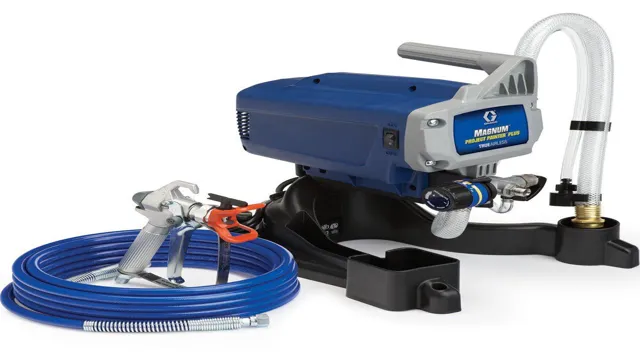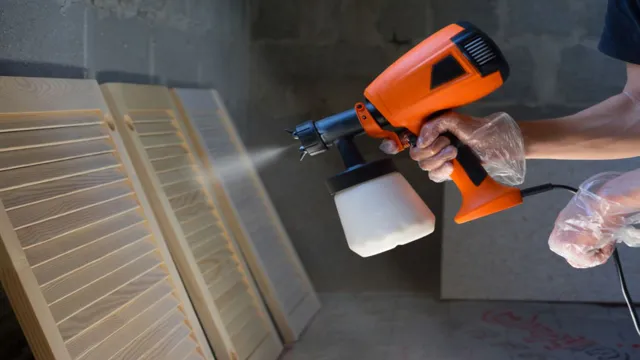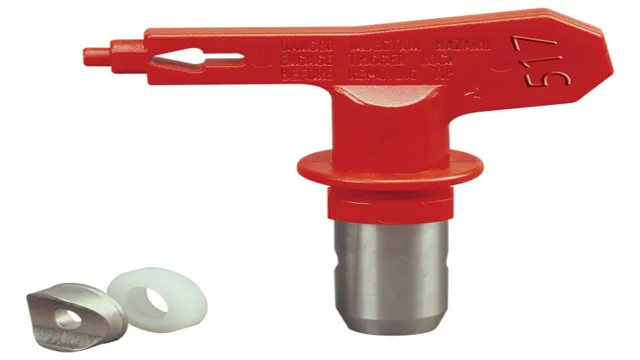What’s the Difference Between Airless and Air Paint Sprayer: A Comprehensive Guide for Prospective Buyers
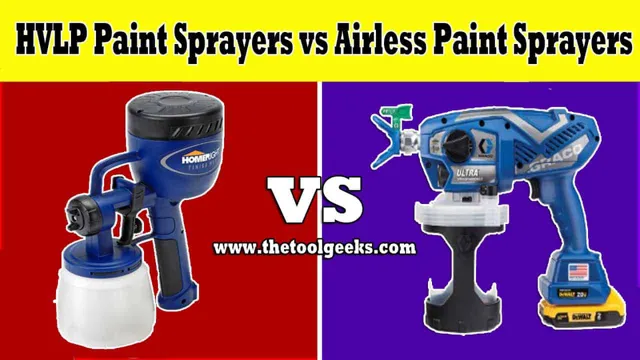
When it comes to painting, choosing the right tool can mean the difference between a successful project and a frustrating mess. Airless and air paint sprayers are two of the most popular options on the market, but deciding between them can be overwhelming. How do you know which one is best for you? An airless paint sprayer uses a pump to force paint through a small tip at high pressure, creating a fine mist that covers surfaces evenly.
This makes it ideal for larger projects, such as painting walls or ceilings. On the other hand, an air paint sprayer uses compressed air to atomize paint, producing a softer spray pattern that’s better suited for intricate jobs, such as painting furniture or trim. Both options have their pros and cons, so it ultimately comes down to your specific needs and preferences.
Do you have a big project that needs to be done quickly? An airless sprayer may be the way to go. Are you looking for more precision and control? An air sprayer might be a better fit. In this blog, we’ll explore the differences between airless and air paint sprayers in depth, discussing the advantages and disadvantages of each.
We’ll also offer some tips and considerations to help you make the best decision for your next painting project. So, whether you’re a seasoned DIYer or a first-time painter, read on to learn more about these two popular tools!
Introduction
Wondering about the difference between airless and air paint sprayers? Let’s break it down. An air paint sprayer utilizes compressed air to atomize the paint, creating a fine mist that provides a smooth surface finish. On the other hand, an airless paint sprayer pumps paint at high pressure through a small tip, creating a fan-like spray pattern that can cover large areas quickly.
While both types of paint sprayers have their benefits, choosing the right one for your project depends on your specific needs and preferences. Air paint sprayers are generally better for more intricate jobs, while airless sprayers are ideal for larger surfaces. Make sure to consider factors such as cost, maintenance, and skill level before making your final decision.
– Brief explanation of the two types of paint sprayers
When it comes to painting, there are two types of paint sprayers: airless and HVLP (High Volume Low Pressure). Airless sprayers use high pressure to atomize the paint into small droplets, which are then sprayed onto the surface. This type of sprayer is great for larger projects and can handle a wide range of materials, including thick paints and coatings.
On the other hand, HVLP sprayers use a lower pressure and higher volume of air to atomize the paint. This results in less overspray and a finer finish, making them ideal for smaller projects or delicate surfaces. Both types of sprayers have their pros and cons, so it’s important to consider the specific requirements of your project before deciding which one to use.
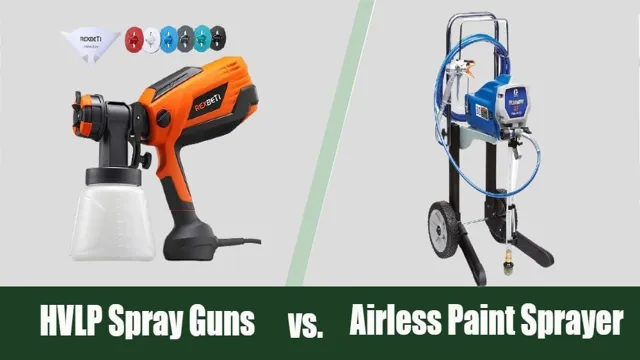
Air Paint Sprayers
If you’re looking to buy a paint sprayer, you might be wondering which type is right for your needs: airless or air paint sprayer? The main difference between the two is how they use air pressure to atomize the paint. An airless paint sprayer pumps the paint under high pressure through a small tip to atomize the paint particles, while an air sprayer uses compressed air to create a fine mist of paint droplets. Airless sprayers are better suited for larger projects, as they can handle thicker paints and can cover a larger surface area in less time.
Air sprayers are ideal for smaller projects and delicate finishes, as they can create a smoother finish with less overspray. Ultimately, the choice between the two types of sprayers depends on your specific needs and preferences.
– Describing air paint sprayers
Air paint sprayers are tools used for painting surfaces and they work by atomizing paint into a fine mist or spray. They are commonly used by professionals such as painters and decorators, but homeowners can also use them for DIY projects. Air paint sprayers come with a variety of different sized nozzles, which affect the size of the spray pattern and allow for different types of coatings and finishes.
They are often preferred over traditional paintbrushes or rollers because they are able to provide an even and smooth finish in a fraction of the time it would take to do manually. Additionally, they are able to reach tight or hard-to-reach areas, making them incredibly versatile. When using air paint sprayers, it’s important to ensure proper ventilation and safety precautions are taken to avoid accidental inhalation or skin contact with the paint.
– Advantages of air paint sprayers
Air paint sprayers are a great tool for anyone who wants to achieve a professional-level finish on their paint job. Among the advantages of this type of sprayer is the control it provides, allowing you to adjust the amount of paint and pressure you use based on the project’s needs. This level of control ensures that you can achieve the desired texture, thickness, and finish without compromising on quality.
Additionally, air paint sprayers are incredibly efficient, meaning that you can cover larger surfaces in a shorter amount of time. This saves you both time and money on your painting project. Another key advantage of air paint sprayers is the versatility they offer.
You can use them to apply a wide range of coatings, including enamels, primers, lacquers, and stains. This makes them an ideal choice for painting doors, cabinets, furniture, and other items that require precise application. Overall, air paint sprayers are a valuable tool for anyone who wants to achieve a smooth, professional-looking finish on their painting projects.
– Disadvantages of air paint sprayers
Air paint sprayers can be a great addition to any painting project, but they also have some drawbacks to consider. One of the biggest disadvantages of air paint sprayers is their noise level. These machines can be extremely loud, making it difficult to work in certain environments or at certain times of the day.
They can also be quite messy, with overspray creating a cloud of paint particles in the air and causing a significant amount of waste. Air paint sprayers also require a significant amount of maintenance, including regular cleaning and maintenance of the spray gun and filters. Additionally, they can be quite expensive to purchase and use, making them less economical than other painting tools.
Despite these drawbacks, air paint sprayers remain a popular choice among DIYers and professionals due to their speed and versatility.
Airless Paint Sprayers
Airless paint sprayers utilize high pressure to force paint through a small opening, creating a fine spray that can cover large surfaces quickly and evenly. In contrast, air paint sprayers use compressed air to atomize the paint, creating a mist that can also provide a smooth finish but can be more difficult to control than an airless sprayer. The main difference between the two is that air sprayers tend to be better suited for smaller projects or detailed work, while airless sprayers can handle larger jobs with ease.
Another advantage of airless sprayers is that they can handle thicker paints, like latex or acrylics, which would clog an air sprayer’s nozzle. Overall, the decision to use an airless or air paint sprayer ultimately depends on the project size, type of paint, and desired finish.
– Describing airless paint sprayers
Airless paint sprayers are essential tools for painting large surfaces quickly and efficiently. These sprayers work by forcing paint through a small nozzle at high pressure, atomizing the paint into a fine mist that can be sprayed onto surfaces evenly and with precision. Unlike traditional paint sprayers that use compressed air to atomize the paint, airless sprayers do not rely on air, making them more powerful and faster.
Airless paint sprayers are perfect for large-scale projects such as painting a house or a commercial building, as they can cover a large area with less effort and in a shorter time. With their high-power motors and durable construction materials, airless paint sprayers are powerful and reliable tools that can handle any painting job with ease. They are easy to use and come in various sizes and configurations to meet the needs of any painting project.
Whether you’re a professional painter or a DIY enthusiast, an airless paint sprayer is a must-have tool that makes painting a breeze.
– Advantages of airless paint sprayers
Airless paint sprayers offer several advantages over traditional paint application methods. Firstly, they are much faster and more efficient than using a paintbrush or roller, allowing for quick completion of large projects. Additionally, airless sprayers ensure that the paint is applied evenly and smoothly, resulting in a more professional finish.
They also allow for better control over the thickness of the paint, reducing the risk of drips and runs. Another advantage of airless sprayers is that they can handle a wider range of paint types, including thicker and more viscous paints. This makes them a versatile tool for both home and professional use.
Overall, the convenience, speed, and quality offered by airless paint sprayers make them a worthwhile investment for anyone who frequently works with paint.
– Disadvantages of airless paint sprayers
Airless paint sprayers are popular among professionals and DIY enthusiasts for their speed and efficiency. However, like any other technology, they also come with a few drawbacks. One of the main disadvantages of airless paint sprayers is that they tend to produce more overspray than other types of sprayers, resulting in wasted paint and increased cleanup time.
Additionally, airless sprayers can be quite loud, making them unsuitable for use in noise-sensitive environments. They also require a higher level of skill to operate properly, which means that beginners may struggle to achieve optimal results without proper training. Another disadvantage is that airless sprayers can be expensive to purchase and maintain, which may not be feasible for casual users who only need to paint infrequently.
Despite these downsides, airless paint sprayers remain a great choice for professionals undertaking large projects, where their speed and efficiency make up for their higher cost and louder noise output.
Which Paint Sprayer Should You Choose?
Choosing between airless and air paint sprayers can be a challenging task, but understanding the differences can help you make an informed decision. The primary difference between the two is the method of atomization. Air sprayers use compressed air to atomize the paint, while airless sprayers use high-pressure pumps to create a spray pattern.
Air sprayers are suitable for smaller projects or detailed work, while airless sprayers are ideal for covering larger surfaces quickly and evenly. Additionally, airless sprayers can handle thicker paints, while air sprayers require thinning of the paint. Both types of sprayers have their advantages and disadvantages, so it is essential to consider your project’s size, materials, and the finish you are looking for before making your final decision.
– Factors to consider when choosing between airless and air sprayers
When selecting a paint sprayer, it’s essential to consider the factors that make the most sense for your project. Airless sprayers are ideal for large areas, applying thicker materials and when you require to paint quickly. On the other side, air sprayers produce a better finish of high-level detail.
It requires more time to prepare and clean, but it’s worth it for car painting or any detailed painting. Furthermore, airless sprayers use high pressure that can create overspray, while air sprayers control how much paint is dispensed and where it goes. Remember, the best paint sprayer will be different depending on your project, so it’s essential to consider the main factors that matter most, like the paint type, size, surface texture, and your expertise level.
Choose a spray gun that meets your comfort level and budget.
– Examples of projects where each type of sprayer may be best suited
When it comes to choosing the best paint sprayer for your project, it all depends on the nature of the job and your individual needs. Firstly, airless sprayers are ideal for larger projects that require thicker paints or coatings, such as painting a house exterior or spraying a fence. They use a powerful motor to force paint through a small nozzle, providing maximum control and coverage.
Secondly, HVLP sprayers are a better choice for smaller jobs or those that require more finesse, such as painting furniture or cabinets. These sprayers use a high volume of air at a low pressure to atomize the paint, resulting in a highly precise and even finish. Finally, handheld sprayers are perfect for quick touch-ups or spray-on-the-go projects, offering flexibility and convenience.
Ultimately, consider the scope and nature of your project to determine which type of sprayer would best suit your needs.
Conclusion
At the end of the day, the difference between airless and air paint sprayers comes down to one simple factor: air. Airless sprayers operate by using high pressure to force paint out of the nozzle, while air sprayers use compressed air to atomize the paint. So, if you want a more streamlined, efficient painting experience that doesn’t rely on a separate air source, go airless.
But if you prefer a more versatile sprayer that gives you greater control over the atomization and blending of your paint, an air sprayer might be the way to go. Ultimately, it’s up to you to determine which type of paint sprayer best suits your needs – but hopefully this comparison has given you some food for thought as you make your decision!”
– Recap of the differences between airless and air paint sprayers
When it comes to choosing between airless and air paint sprayers, there are several factors to consider. Airless sprayers are known for their ability to cover large areas quickly with a thick and even coat of paint. They are also capable of spraying a variety of materials, from latex and oil-based paints to stains and varnishes.
On the other hand, air sprayers are ideal for precision work and can create a fine finish on cabinets, furniture, and other small projects. They rely on compressed air to atomize the paint, resulting in a smooth and consistent application. Ultimately, the choice between the two depends on the project at hand and your personal preferences.
If you need to cover a large area in a short amount of time, an airless sprayer may be the better choice. However, if you are working on a smaller project that requires a high level of detail, an air sprayer may be more suitable. At the end, the best choice will depend on your needs and the specific project you’re working on.
– Recommendations based on the type of project and skill level
When it comes to choosing a paint sprayer, it’s important to consider the type of project you’re working on and your skill level. For bigger projects, such as painting the exterior of a house, you’ll want a high-volume, low-pressure (HVLP) sprayer. These sprayers have a larger spray pattern and allow for thicker coatings, making them ideal for larger surfaces.
However, they can be more challenging to use, so if you’re a beginner, it may be best to start with a smaller project and work your way up. For smaller projects, such as furniture refinishing, an airless sprayer is a good choice. These sprayers are easier to use and provide a smoother finish, making them ideal for intricate work.
However, they require more prep work and may not be as versatile as HVLP sprayers. Ultimately, the best paint sprayer for you depends on your specific needs and skill level.
FAQs
What is an airless paint sprayer?
An airless paint sprayer uses high pressure to spray paint without the need for compressed air.
What is an air paint sprayer?
An air paint sprayer uses compressed air to atomize and spray paint.
What are the benefits of using an airless paint sprayer?
Airless paint sprayers are faster, more efficient, and provide a more even coat than traditional spray guns.
What are the benefits of using an air paint sprayer?
Air paint sprayers are great for smaller projects and touch-ups, as well as more detailed work.
Which type of paint sprayer is better for outdoor use?
An airless paint sprayer is better for outdoor use, as it can handle thicker paint and larger surfaces more quickly.
Which type of paint sprayer is better for indoor use?
An air paint sprayer is better for indoor use, as it produces less overspray and is better suited for smaller, more detailed projects.
Are airless paint sprayers more expensive than air paint sprayers?
Generally, yes. Airless paint sprayers tend to be more expensive due to their higher efficiency and power.

